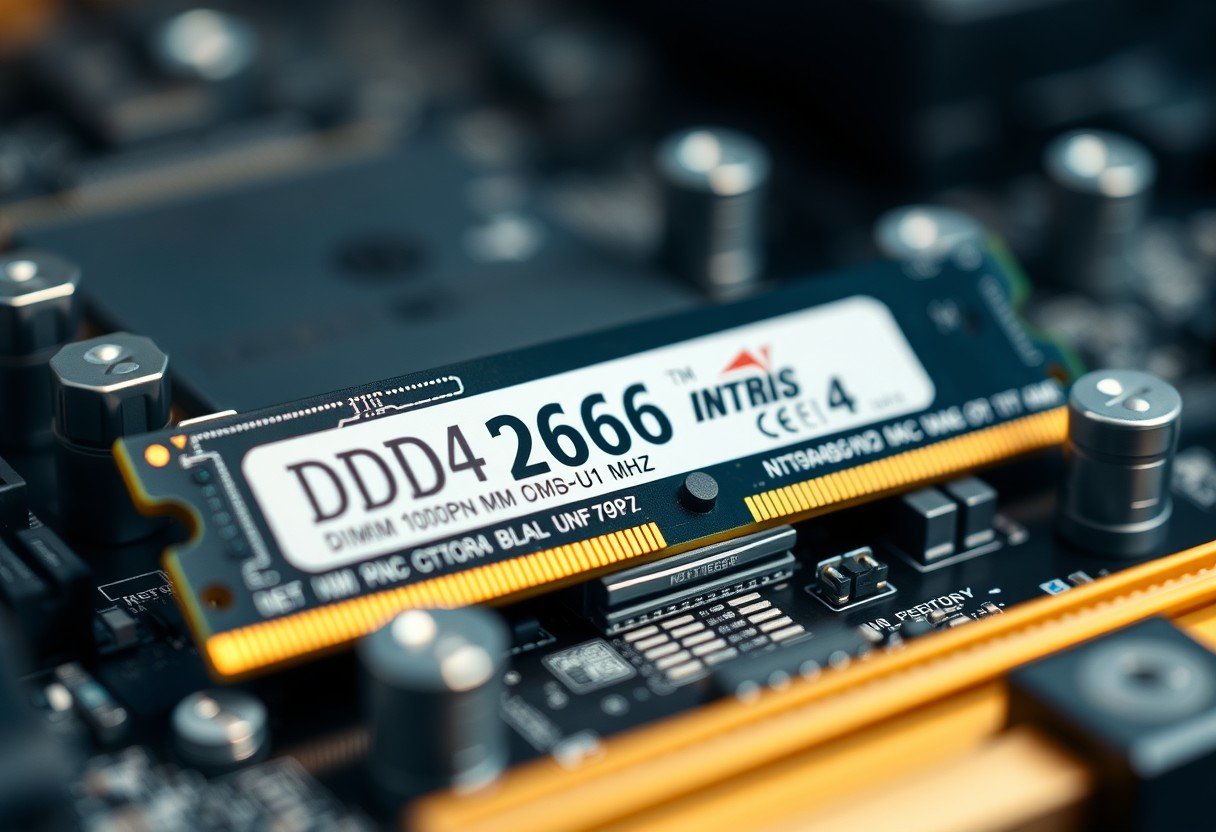If you’re looking at a DDR4 DIMM memory module running at a speed of 2666 MHz, you’re likely wondering what its PC rating is. This specific memory speed corresponds to a **PC4-21300** rating. Knowing this helps you understand its data transfer capability, which is crucial for ensuring compatibility and maximizing your computer’s performance when building or upgrading your system. This rating essentially tells you the peak bandwidth of the memory module.
Understanding DDR4 DIMM and its Features
Before diving into ratings and speeds, it’s helpful to know what a DDR4 DIMM is. DDR4 stands for “Double Data Rate 4,” and it’s a modern type of computer memory that offers better speed and efficiency than its predecessors like DDR3. A DIMM, or “Dual Inline Memory Module,” is the physical circuit board that the memory chips are on, which you plug into your computer’s motherboard.
This technology is designed to handle the heavy demands of modern computing, from intense gaming sessions to complex content creation. It has become the standard for most new PCs because it provides a significant boost in performance while using less power.
DDR4 memory comes with several improvements that make it a superior choice for today’s systems. These enhancements work together to provide a faster and more reliable computing experience.
- Higher Data Transfer Rates: DDR4 starts at higher speeds than DDR3, allowing for quicker data processing.
- Improved Power Efficiency: It operates at a lower voltage (1.2V compared to DDR3’s 1.5V), which reduces power consumption and heat output.
- Increased Capacity: DDR4 DIMMs can support much higher capacities, allowing you to install more RAM in your system.
These features are why DDR4 remains a popular choice for building powerful and efficient computers that can handle multitasking and demanding applications without slowing down.
How Memory Speed Impacts Your PC’s Performance
Memory speed, measured in megahertz (MHz), plays a vital role in your system’s overall responsiveness. It determines how quickly the CPU can read and write data from the RAM. A higher memory speed means data is transferred faster, which can reduce loading times and make your system feel snappier.
For a DDR4 module running at 2666 MHz, you get a solid, mid-range performance that is suitable for most everyday tasks and gaming. While faster speeds like 3200 MHz or 3600 MHz exist, 2666 MHz provides a great balance between cost and performance for many users. It allows for smooth multitasking and efficient handling of applications without creating a bottleneck between your CPU and memory.
Decoding the PC Rating: What Does it Mean?
The PC rating is a more technical way to describe a memory module’s performance. Instead of showing the speed in MHz, it represents the maximum theoretical bandwidth of the RAM in megabytes per second (MB/s). This is arguably a more useful metric because it tells you the total amount of data the module can transfer each second.
This rating is essential for ensuring compatibility. When buying RAM, you need to match the PC rating with what your motherboard supports. Using a module with a rating that’s too high for your motherboard might result in it running at a slower, supported speed.
Calculating the PC Rating for 2666 MHz RAM
The formula to calculate the PC rating is quite simple. You take the memory’s speed in MHz and multiply it by 8. This works because DDR memory transfers 64 bits of data at a time, and there are 8 bytes in 64 bits.
So, for a 2666 MHz DDR4 DIMM, the calculation is:
2666 MHz x 8 = 21,328 MB/s
This number represents the peak data transfer rate. For labeling purposes, this is typically rounded to the nearest hundred, which gives us the official PC rating. Therefore, a 2666 MHz module is classified as **PC4-21300**. The “PC4” prefix simply indicates that it is DDR4 memory.
2666 MHz vs. Other DDR4 Speeds: A Comparison
To put the performance of 2666 MHz RAM into perspective, it’s useful to compare it against other common DDR4 speeds. As the speed in MHz increases, so does the PC rating and the overall bandwidth. This can lead to noticeable performance gains in memory-intensive applications.
The table below shows how 2666 MHz stacks up against other popular DDR4 options.
| Memory Speed (MHz) | PC Rating |
|---|---|
| 2133 | PC4-17000 |
| 2400 | PC4-19200 |
| 2666 | PC4-21300 |
| 3000 | PC4-24000 |
While higher speeds offer better performance on paper, the real-world difference can depend heavily on your CPU and the specific applications you are using.
Compatibility and Best Uses for 2666 MHz DDR4
A DDR4 DIMM running at 2666 MHz is a versatile choice suitable for a wide range of computer builds. It is an excellent option for mainstream gaming PCs, office workstations, and general-purpose home computers. It provides enough bandwidth to handle modern games, productivity software, and web browsing without issues.
However, compatibility is key. Before purchasing, you must check your motherboard’s specifications to ensure it supports DDR4 memory at 2666 MHz. Most modern motherboards do, but it’s always best to verify. If you install RAM that is faster than what your motherboard supports, it will likely just run at the highest supported speed, meaning you won’t get the performance you paid for.
Also, remember that if you mix RAM modules of different speeds, all modules will operate at the speed of the slowest one installed. For the best results, it’s recommended to use identical RAM sticks.
The Future Beyond DDR4: A Look at DDR5
While DDR4 is still very common and powerful enough for most users, memory technology continues to evolve. The next generation, DDR5, is becoming more widespread in new high-end systems. DDR5 offers significant improvements over DDR4, including much higher starting speeds (4800 MHz and beyond), greater memory densities, and better power efficiency.
This transition means that while DDR4 2666 MHz is a great option now, those building a top-of-the-line PC for the future might consider a DDR5-compatible motherboard and CPU. For now, DDR4 provides excellent value and performance for the vast majority of PC builders and upgraders.
Frequently Asked Questions
What is the PC rating of a DDR4 DIMM running at 2666 MHz?
A DDR4 DIMM with a speed of 2666 MHz has a PC rating of PC4-21300. This is calculated by multiplying the speed (2666) by 8, which equals 21,328 MB/s, and then rounding to the nearest hundred.
Is 2666 MHz fast enough for modern gaming?
Yes, for most games, 2666 MHz DDR4 RAM provides sufficient performance for a smooth experience. While faster RAM can provide a slight frame rate boost in certain CPU-intensive games, the GPU and CPU typically have a much larger impact on gaming performance.
How does the PC rating affect system performance?
The PC rating indicates the memory’s maximum bandwidth, or how much data it can transfer per second. A higher rating means faster data transfer, which can improve performance in memory-heavy tasks like video editing, 3D rendering, and multitasking with many applications open.
What happens if I mix 2666 MHz RAM with a faster RAM module?
If you mix RAM modules with different speeds, your system will default to running all modules at the speed of the slowest one. For example, if you pair a 2666 MHz stick with a 3200 MHz stick, both will run at 2666 MHz to ensure stability.
Should I upgrade from 2666 MHz to a higher speed?
Upgrading from 2666 MHz might be worthwhile if you perform memory-intensive tasks and your CPU can take advantage of the extra speed. For general use and most gaming, the performance difference may be minimal, so it’s important to weigh the cost against the potential benefit.








Leave a Comment